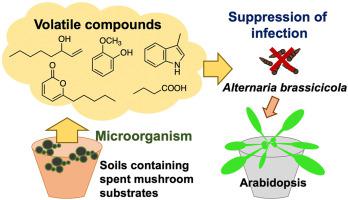Journal of Bioscience and Bioengineering ( IF 2.8 ) Pub Date : 2021-04-16 , DOI: 10.1016/j.jbiosc.2021.03.003 Rina Fujita 1 , Mizuki Yokono 2 , Naoki Ube 3 , Yasuhito Okuda 4 , Shuji Ushijima 4 , Emi Fukushima-Sakuno 4 , Kotomi Ueno 5 , Kumiko Osaki-Oka 5 , Atsushi Ishihara 5

|
Most commercially circulating mushrooms are produced via cultivation using artificially produced mushroom substrates. However, after mushroom harvesting, the disposal of spent mushroom substrates (SMSs) is a serious problem for the mushroom industry owing to the need for a disposal site and the cost involved. Thus, in view of the possibility of recycling SMSs as a soil modifier, we examined the effect of soil mixed with SMSs on the infection of Arabidopsis leaves by Alternaria brassicicola, the causal agent of cabbage leaf spot. The mixing of SMSs used for Hypsizygus marmoreus, Pholiota microspora, Lyophyllum decastes, and Auricularia polytricha into culture soil suppressed the lesion formation caused by A. brassicicola. The defense responses of Arabidopsis were not induced by the culturing of these seedlings in soils containing SMSs. Suppressed lesion formation was observed after the seedlings were treated with volatiles emitted from SMSs that were incubated with soil for 7 days and used for H. marmoreus, P. microspora, L. decastes, A. polytricha, Lentinula edodes, and Cyclocybe cylindracea. The volatiles from the SMSs reduced the elongation of A. brassicicola hyphae. GC–MS analyses of extracts from the SMS containing soils led to the detection of various volatile compounds; among these, skatole, 2,4-di-tert-butylphenol, γ-dodecalactone, butyric acid, guaiacol, 6-amyl-2-pyrone, and 1-octen-3-ol were examined for inhibitory activity on A. brassicicola and found to suppress hyphae elongation. These findings indicate that the antifungal volatile compounds emitted by the SMSs suppress A. brassicicola infection.
中文翻译:

来自废蘑菇基质的挥发性化合物抑制芸苔链格孢菌感染
大多数商业流通的蘑菇是通过使用人工生产的蘑菇基质进行栽培生产的。然而,蘑菇收获后,废弃蘑菇基质 (SMS) 的处理对于蘑菇行业来说是一个严重的问题,因为需要一个处理场所和所涉及的成本。因此,鉴于可回收 SMS 作为土壤改良剂的可能性,我们研究了与 SMS 混合的土壤对白菜叶斑病病原体Alternaria brasicicola感染拟南芥叶子的影响。Hypsizygus marmoreus、Pholiota microspora、Lyophyllum decastes和Auricularia polytricha使用的SMSs混合到培养土壤中抑制了病斑的形成。芸苔属植物。在含有 SMS 的土壤中培养这些幼苗不会诱导拟南芥的防御反应。观察到抑制病变形成的幼苗用从短信发射挥发该孵育土壤7天,并用于处理后真姬菇,P.微孢子,L. decastes,A.木耳,香菇,和Cyclocybe cylindracea的。SMS 中的挥发物降低了A. brasicicola菌丝的伸长率。从含有 SMS 的土壤中提取的 GC-MS 分析导致检测到各种挥发性化合物;在这些之中,粪臭素,2,4-二-叔-丁基苯酚、γ-十二内酯、丁酸、愈创木酚、6-amyl-2-pyrone 和 1-octen-3-ol 对A. brassicicola 的抑制活性进行了检查,发现可抑制菌丝伸长。这些发现表明 SMS 释放的抗真菌挥发性化合物抑制了A. brasicicola感染。


























 京公网安备 11010802027423号
京公网安备 11010802027423号